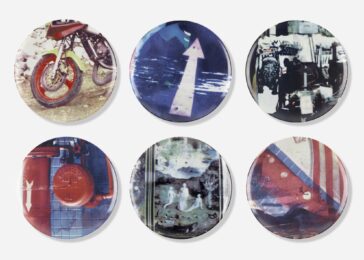

1925-2008
Robert Rauschenberg, an American born in 1925, started producing painterly prints in the early 1960s that contained pictures he cut out of magazines and newspapers. Nearly ten years prior, he had created pieces he dubbed “Combines,” which are fusions of painting and sculpture that embrace the noise of daily life and contrast the solitary canvases of abstract expressionism. The ordinary was also introduced in Rauschenberg’s prints in a variety of ways, such as the water ring left by a drinking glass, the embossment from a coin, or the traced contour of a cane. By reintroducing representation into the avant-garde, the artist revived a vibrant visual language. “What he invented above all was…a graphic surface that let the world in again,” wrote art historian Leo Steinberg.
The unrestricted attitude of Rauschenberg influenced fine art print studios to take new paths. He pushed the boundaries of techniques and materials while collaborating with skilled printers, rethinking standard procedures for lithography, screenprinting, and intaglio, using new techniques like digital imaging, and printing on unusual materials including cardboard, cloth, and plastic. Since imprinting—the very nature of printmaking—had long played a part in Rauschenberg’s work, in the form of fingerprint impressions in his paintings and magazine images transferred to drawings, his move into printmaking seemed to come naturally.
The first person to ask Rauschenberg to manufacture prints was publisher Tatyana Grosman of Universal Limited Art Editions (ULAE) on Long Island, New York. In 1962, he agreed to the invitation, and he has maintained a connection with that atelier ever since.
The early ULAE print Accident highlights Rauschenberg’s appreciation of the unexpected and his skill at using chance to his advantage. He only managed a few impressions before the lithographic stone cracked while printing. Instead of starting over on a different stone, he accepted the rupture, which is represented by the large diagonal crack that bisects the impression of the final edition, and further enhanced the picture with discarded chunks of limestone that were inked and printed in the lower margin. Rauschenberg drew attention to the peculiar procedure of printing from a broken stone by giving the piece the title Accident. He was adopting tactics similar to those of his colleague, the composer John Cage, who used random tones and intervals in his musical pieces by giving status to a random act. Accident gained remarkable recognition for a US artist and atelier as it was published and won first place in a significant international print competition.
Read the Blog: Robert Rauschenberg And His Printmaking.
Read the Blog: Robert Rauschenberg’s Famous Prints.